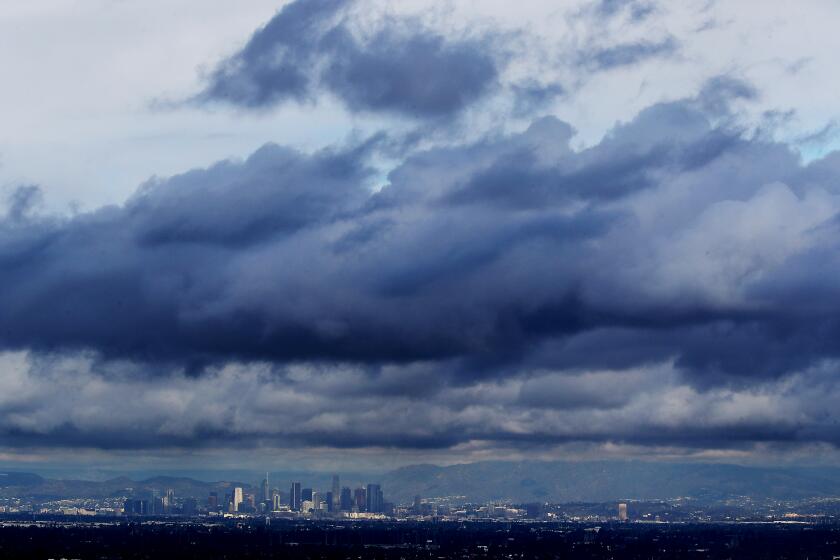Honoring L.A.’s Black Founders
- Share via
As Los Angeles joins the rest of the country in celebrating February as Black History Month, it’s easy to forget that not too long ago, the city seemed to regard its multiracial history as something of an embarrassment.
In the 1950s, a plaque was installed in El Pueblo de Los Angeles State Historic Park, paying tribute to the 11 families who founded Los Angeles on Sept. 4, 1781, after a long trek north from Mexico. They were called pobladores, and more than half of them were black. Those early Angelenos of African descent had Spanish surnames, and their ethnicity would not have been known had the plaque not indicated it.
The plaque soon vanished without a trace.
Rumor had it that several Recreation and Parks commissioners had been displeased by its public display of the role blacks played in city’s founding.
More than 20 years later, another plaque was put in the same spot. It honored the city’s founders without mentioning their race.
That plaque was replaced in 1981--marking the city’s bicentennial--with a simple bronze tablet that tells the pobladores’ names, race, sex and age. It was installed through the trailblazing efforts of Miriam Matthews, California’s first college-trained black librarian.
There are no grandiose monuments, no streets or landmarks named for the 44 pobladores , but the fact is that El Pueblo de Nuestra Senora la Reina de Los Angeles de Porciuncula has been a place of various peoples from the start. And although it may not be possible to trace their presence in concrete and stone, their memories can be followed from place to place across the city’s two centuries of history.
All the original settlers, including black pobladores Luis Quintero and Antonio Mesa, married racially mixed women and built their makeshift houses of willow branches, tule reeds and mud. After several floods, however, they relocated the little pueblo in 1815 to a site just north of the Old Plaza Church. Three years later, the plaza was moved to its present location near Alameda and Macy streets.
The pueblo grew as it pushed on with its handful of multiethnic pioneers. At the turn of the century, the African American community had grown to more than 2,200 people, spreading from 1st and Los Angeles streets to Boyle Heights. West of Downtown, many blacks settled along Jefferson Boulevard, between Normandie and Western avenues and in an area bounded by Beverly Boulevard and Rampart, Temple and Hyans streets. Others bought parcels of land about five miles south of Downtown from an Irish farmer named James Furlong.
In 1905, Furlong subdivided his land bounded by Long Beach Avenue and Alameda, 50th and 55th streets. He sold his lots to black families for the going price of $750.
From the start, the Furlong Tract was a working-class area, settled by people like the Guillebeaus, Postells and Hickses who were barred from other areas by restrictive racial covenants or high prices. The area had convenient transportation (the Main Street car lines ran through the center of the neighborhood). Many families worked for what was then the generous sum of $3.75 a day at such nearby plants as the Cottonseed Oil Mill, the Hercules Foundry and Pioneer Paper Co.
Some families lived in tents while they built their modest homes. Eventually, the tract had more than 200 houses, grocery stores, a pharmacy, doctors’ offices, a florist, dry cleaners, an ice cream parlor, a real estate office, an icehouse, a community hall, three churches and a school.
Built in 1910, the one-story, wood-frame 51st Street School became the first all-black school built in Los Angeles. It hired white teachers because discriminatory hiring kept black teachers out of many cities in the state, including Los Angeles.
The year after it was built, Bessie Bruington Burke became the schools’ first black teacher and eight years later, the schools’ first black principal.
“Mrs. Burke used to make us toe the line, and it wasn’t hard since most of the youngsters were afraid of her,” recalled Paul Postell, who attended the school. “She was one of those principals who didn’t have to say much. She would just look at you. You weren’t even allowed to giggle in the hall.”
*
The school burned down in 1922, and it was renamed the Holmes Avenue School when it was rebuilt.
In 1933, the Long Beach earthquake damaged some of the Furlong Tract homes. A few families started moving to other neighborhoods, and the tract began to decline.
The once neat single-family homes, many with vegetable gardens, were torn down in the 1940s to build Pueblo del Rio, a low-income housing project. The residents scattered and all that remains are a school and the memories of those who grew up there.
More L.A. History
* Reprints of select Then and Now articles, including a profile of African-American journalist Charlotta Bass, are available from Times on Demand. To order, call 808-8463, press *8630 and select option 1. Order No. 5532. $2.00 plus 50 cents for delivery.
Details on Times electronic services, A6
More to Read
Sign up for Essential California
The most important California stories and recommendations in your inbox every morning.
You may occasionally receive promotional content from the Los Angeles Times.










